Care for the Common Critter
Air Date: Week of January 1, 2021
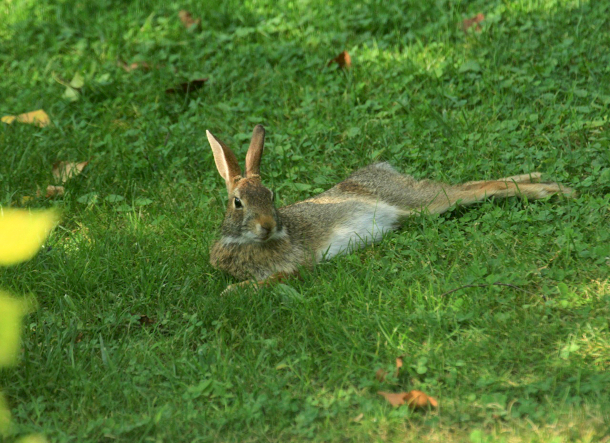
A wild rabbit Julie Zickefoose loved which she called “Red,” relaxing in her yard. (Photo: Julie Zickefoose)
As a wildlife rehabilitator, Julie Zickefoose has had some remarkable encounters with animals. She joins Bobby Bascomb to share some of her own stories and animal insights as well as tales of uncommon encounters others have had while helping common woodchucks and rabbits in need.
Transcript
BASCOMB: From PRX and the Jennifer and Ted Stanley studios at the University of Massachusetts Boston, this is Living on Earth. I’m Bobby Bascomb.
DOERING: I’m Jenni Doering.
O’NEILL: And I’m Aynsley O’Neill.
As you guys know, for these couple of weeks around the holidays and the winter solstice we like to take a little break from the news to share some storytelling on the show.
DOERING: Yeah, and for today’s show, we asked some of our favorite story tellers and guests to share some of their animal stories with us. Bobby, I think you talked with Julie Zickefoose I mean, thanks to her I’m noticing blue jays everywhere these days.
BASCOMB: Yeah me too! She told us about a baby blue jay that she raised and released into the wild. She wrote and illustrated a beautiful book about Jemima, that baby blue jay. And when I talked with her I learned she’s had some really amazing experiences with all kind of animals in her work as a wildlife rehabilitator. So, take a listen. She’s really got a soft spot for animals that a lot of us might think of as pests.
ZICKEFOOSE: I have a special affection for woodchucks. Woodchucks are just extraordinary animals, and I think that only those of us who've come to know them personally might realize this. I think a lot of people think of them as just big garden eaters and diggers and things like that. But I had a friend who's now passed on. His name was Tom Ross, and he lived in the Amish country of Ohio. And he shared this story with me.
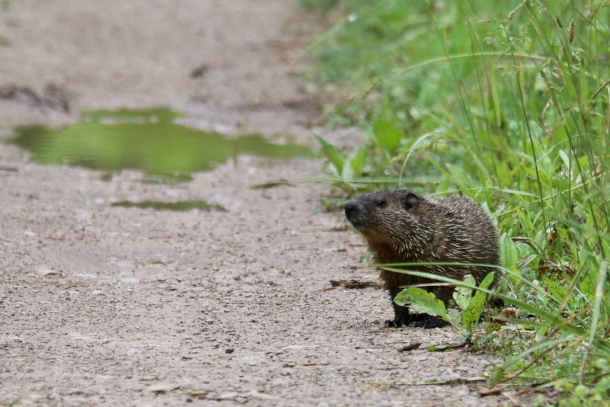
A wild woodchuck encountered on one of Julie’s hikes. (Photo: Julie Zickefoose)
[MUSIC: Josh Kimbrough, "Glowing Treetops" on Slither, Soar & Disappear, Tompkins Square Records 2020]
In the early 1970s, Tom had an office, he was an architect. And it was in a home that was completely surrounded by commercial developments, strip malls and stores and that kind of thing. And a woodchuck somehow hung on and lived in the hedge in the front of the building, and had a burrow down there, and it grazed out on the lawn. And one day Tom received notice that the building was going to be demolished. And he knew that the woodchuck would be killed when the lot was bulldozed. So he was afraid what would become of it. So he moved his office, all the architects got their stuff out, and they were loading up their cars with all their stuff. And Tom had brought a wooden cage from home, and he was intending to live trap this woodchuck and then move it to safety. And he wrote me a letter about this, he said:
"When we had finished loading the car, I walked around the front to try to spot the woodchuck's hole. Parting the yews planted around the foundation, I was shocked to see the woodchuck sitting there, looking up at me.”
[MUSIC: Josh Kimbrough, "Glowing Treetops" on Slither, Soar & Disappear, Tompkins Square Records 2020]
"He was not timid and didn't run. It was almost as if he'd been expecting me. As I stood transfixed, he came to the front of the bushes and stood up with his front paws on my leg like a dog. I reached down and scratched the top of his head, then slowly backed up and started to the back of the house to get the cage. At this, he followed me around the house, walked of his own volition straight into the cage, and I closed the gate. We then placed the cage in the car, drove out to the country where I keep my bees and released him. The woodchuck set up housekeeping there, and I saw him frequently the rest of the summer."
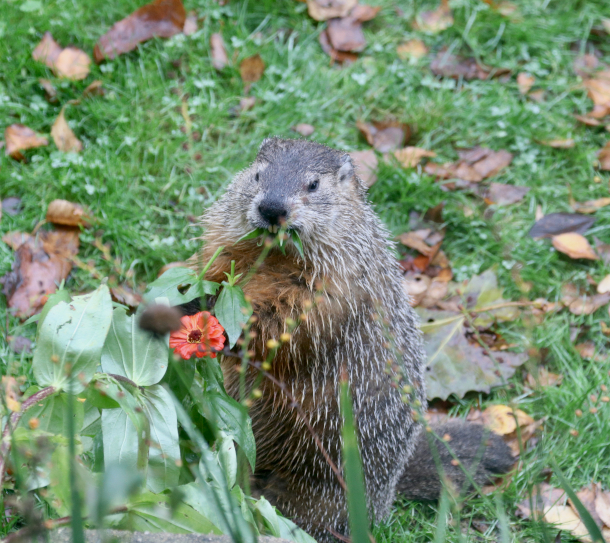
A woodchuck who hung around Julie’s yard this summer and fall, destroying a zinnia. (Photo: Julie Zickefoose)
BASCOMB: Wow, that's amazing. So the woodchuck knew? I mean, how did the woodchuck know what was going to happen, and that this was somebody who could help him?
ZICKEFOOSE: Yeah, exactly. I think there is a mechanism by which the woodchuck knew. I think that he was seeing what was going on. He saw the people moving out. But he also saw the pictures in Tom's mind of the demolishing of the house. He sensed the concern. He received the message that something bad was about to happen to his home. And I think he did what made sense to him, which was to let the person help him.
BASCOMB: And, so I understand that you have another story for us about people helping animals.
ZICKEFOOSE: Well, I do. And again, I'm going to talk about a garden pest, a cottontail rabbit, which is not something you want in your garden.
BASCOMB: No.
ZICKEFOOSE: But this one spring, I was rototilling my garden and I noticed a little tiny tuft of rabbit fur, next to a bale of straw. And I knew what that meant. I put my finger down through the straw and into the earth. And there was a little fur-lined bowl there and there were some warm, slippery, sleek baby rabbits in there.
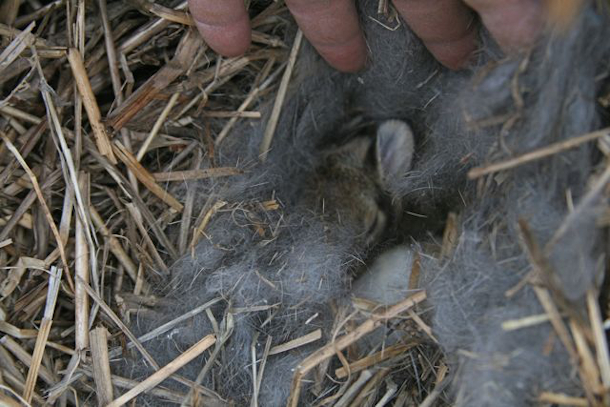
What it's like to find a rabbit nest. That sudden intake of breath at the perfection hiding under the fur and straw. (Photo: Julie Zickefoose)
[MUSIC: Josh Kimbrough, "Eyes on the Moon" on Slither, Soar & Disappear, Tompkins Square Records 2020]
The mother rabbit pulls fur out of her belly and makes a beautiful blanket that she pulls over the babies when she has to leave them. And so there they were. And I thought, Oh my gosh, I've got to stop all operations in here right now. So I put the blanket back over them. And that night there was supposed to be a violent thunderstorm. So I put a wheelbarrow upside down, elevated by a couple of bricks so that the rabbit could crawl under it, but, you know, nothing else could get to them. So sure enough, when I went to check them in the morning, they were warm and dry under there and obviously the rabbit had crawled in in the night to nurse them. That's what rabbits do. They nurse their babies all night and then they leave them all day.
BASCOMB: Hmm.
ZICKEFOOSE: So I went ahead and planted the peas and the lettuce, and I left the nest with the wheelbarrow over it alone and I checked on the little rabbit kits every couple of days to make sure they were still all right.
[MUSIC: Josh Kimbrough, "Eyes on the Moon" on Slither, Soar & Disappear, Tompkins Square Records 2020]
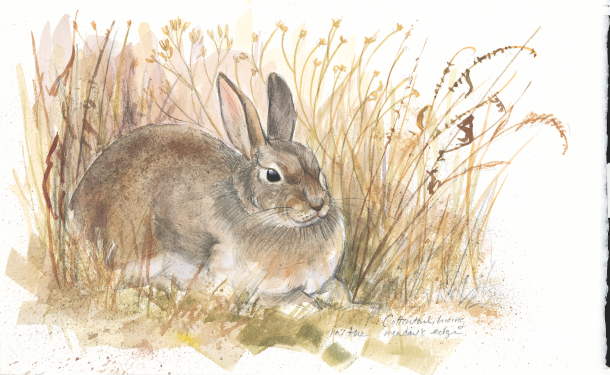
A watercolor by Julie Zickefoose of a resting cottontail, done from life. (Image: Julie Zickefoose)
And one day I forgot and I closed the garden door, and she had been just coming in and out of the open door of the fencing, and she had chewed a five-inch hole in the mesh to get through to her babies, so nothing was gonna stop her. Anyway, the babies made it fine, they left, everything was great. And I was very, very glad that I'd discovered that nest and didn't rototill it up. So then I got to thinking about back to the mid 1970s, when I was going to a lot of old-time music festivals, and there was this one called Brandywine in Pennsylvania, and it was a fabulous time. And what they would do was every summer they would mow this hay field. And that would be pressed into service as a parking lot. And then people also would cast their tents in the lot. So I had just gotten there. And I was walking toward the sound of the fiddles and the banjos, and I was all excited, I had my big gypsy skirt on and my felt hat. And I saw a little tuft of rabbit fur in the hay.
[MUSIC: Josh Kimbrough, "Glowing Treetops" on Slither, Soar & Disappear, Tompkins Square Records 2020]
And I thought, Oh, boy. So I felt down through the hay that had been cut. And sure enough, there were these pink naked baby rabbits there, in a nest. And I looked to the left and there was a tent and to the right, there was another tent, and then behind me were cars. It was overrun by people. So I thought, Ah! What do I do, this is a four day festival. I can't take the rabbits, I've got to make it so that the mother can get to them but nobody will step on them or drive over them. So I found some wooden stakes and some twine and some paper and I cordoned off the nest and I made a sign that said, "Rabbit Nest, Please Keep Away." So there was just this little triangle, this little oasis for these babies. And every morning I came back to check on the baby rabbits.
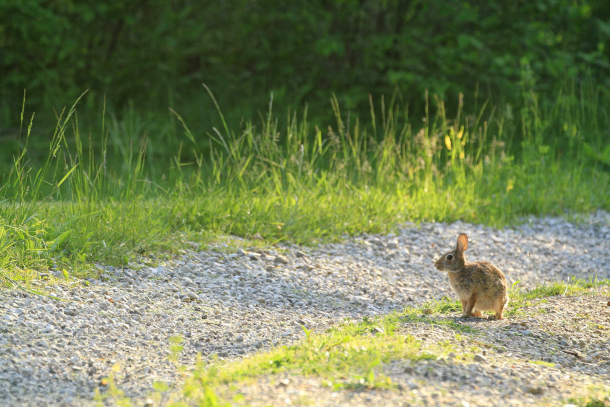
“Spring” the rabbit in Julie’s driveway. (Photo: Julie Zickefoose)
[MUSIC: Josh Kimbrough, "Glowing Treetops" on Slither, Soar & Disappear, Tompkins Square Records 2020]
And each time they were warm and dry, and their bellies were round and full. And I realized that this mother rabbit had made her way through enemy lines at night, past the tents and the cars and the people playing in the parking lot, to nurse her young, and she had made it happen. So at the end of the four-day festival, everybody packed up their tents and left, and the young rabbits were still alive and warm and waiting for their mother.
BASCOMB: Oh, that's a beautiful story. There's nothing like the determination of a mother, you know?
ZICKEFOOSE: Exactly. I mean, she was not going to let anything stop her. And I think people think of rabbits as these timid little shivering animals, but they're anything but. This mother wanted to get to her babies and by God, she did.
BASCOMB: Mm hmm.
ZICKEFOOSE: She just needed a little help.
BASCOMB: Yeah. And I understand you have one more story for us, also about rabbits.
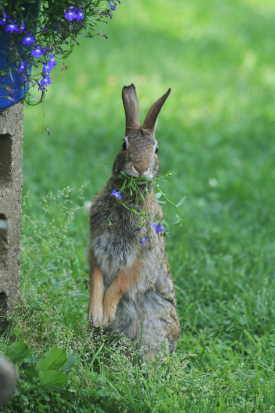
A rabbit Julie called “Notch”, whom Julie adored even though he ate all the lobelia. (Photo: Julie Zickefoose)
ZICKEFOOSE: I do. And again, it's a wonderful story, but it's not mine. This is a friend of mine, who like Tom Ross has also passed away. She was an incredible woman named Christine Carpenter. And she had wild rabbits come up to her and ask for help.
[MUSIC: Blue Dot Sessions, "Suzy Textile" on Cloud Harbor, Blue Dot Studios 2020]
It started with one rabbit. She and her husband saw a rabbit lying by a cherry tree in their yard, this was in Ohio. And they went over and looked at it, figuring it was dying, and it was certainly in bad shape. There's a parasite that rabbits get, and it's called a warble fly. It lays its egg under the skin of the rabbit. And then the larva grows up as a parasite and makes a big knot on the skin of the rabbit. A really badly afflicted rabbit kind of looks like a sack of marbles.
BASCOMB: Hmm.
ZICKEFOOSE: So this poor rabbit was covered with warble fly larvae and knots. They saw the warbles they had seen them on tame rabbits and knew what to do.
[MUSIC: Blue Dot Sessions, "Suzy Textile" on Cloud Harbor, Blue Dot Studios 2020]
So they put on gloves and they got a needle nose pliers and a scissors. And they removed all the warble larvae from this animal. It allowed them to do it. It didn't struggle. They brought it into the house. They gave it some water and some food, and they put it in the bathtub overnight and they were pretty sure it would be dead in the morning. But in the morning, it was ricocheting around the bathtub. And they opened the bathroom door and the door to the outside and the rabbit rocketed out into the yard and was clearly still fine. And, one might presume, grateful. So they thought, Well, that was cool.
[MUSIC: Blue Dot Sessions, "Suzy Textile" on Cloud Harbor, Blue Dot Studios 2020]
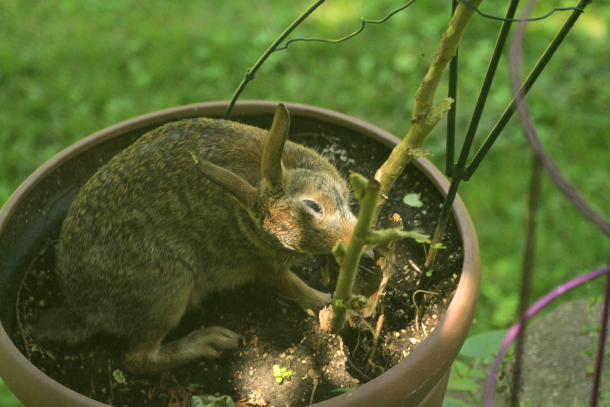
Notch, destroying a once-luxuriant geranium. He climbed up into Julie’s planters to do his dirty work. (Photo: Julie Zickefoose)
But then, what happened was, two more rabbits presented themselves to Christine. They came up to her, and they, too, had bad warbles. And, again, Christine and her husband gloved up and put on long sleeves and you know, held the rabbits which struggled a little, as a wild rabbit would, but they allow themselves to be picked up. And they allow the operation to be done. And they went out and prospered after that.
BASCOMB: You know, Julie, it reminds me of your story of the woodchuck. You know, the woodchuck somehow knew that this guy was gonna, gonna help him, and the rabbits just somehow knew that, you know, there was a friend here that could help them out. And it's really nice to think of.
ZICKEFOOSE: Yeah. Well, it's, you know, lots of people are probably familiar with the tale of Androcles and the Lion, where a wild lion allowed Androcles to remove a thorn from its paw. So clearly, this is an old archetype. This is something that people have been doing with animals for many, many, many centuries. And I think it's something that, that we need to look for in everyday life and, and look for ways to stop and help animals. It's a different way to look at the natural world, and a beautiful way, really.
[MUSIC: Josh Kimbrough, "Eyes on the Moon" on Slither, Soar & Disappear, Tompkins Square Records 2020]
BASCOMB: Julie Zickefoose is a part-time wildlife rehabilitator, artist and author of several books, including Saving Jemima: Life and Love with a Hard-luck Jay. Julie, thank you so much for sharing all of these wonderful stories with us.
ZICKEFOOSE: Well thank you, Bobby. It's such an honor to be on Living on Earth. Thank you so much.
Links
Find Julie’s books, artwork and more here
Julie’s LOE interview about her book “Saving Jemima: Life and Love with a Hard-Luck Jay”
Living on Earth wants to hear from you!
Living on Earth
62 Calef Highway, Suite 212
Lee, NH 03861
Telephone: 617-287-4121
E-mail: comments@loe.org
Newsletter [Click here]
Donate to Living on Earth!
Living on Earth is an independent media program and relies entirely on contributions from listeners and institutions supporting public service. Please donate now to preserve an independent environmental voice.
NewsletterLiving on Earth offers a weekly delivery of the show's rundown to your mailbox. Sign up for our newsletter today!
 Sailors For The Sea: Be the change you want to sea.
Sailors For The Sea: Be the change you want to sea.
 The Grantham Foundation for the Protection of the Environment: Committed to protecting and improving the health of the global environment.
The Grantham Foundation for the Protection of the Environment: Committed to protecting and improving the health of the global environment.
 Contribute to Living on Earth and receive, as our gift to you, an archival print of one of Mark Seth Lender's extraordinary wildlife photographs. Follow the link to see Mark's current collection of photographs.
Contribute to Living on Earth and receive, as our gift to you, an archival print of one of Mark Seth Lender's extraordinary wildlife photographs. Follow the link to see Mark's current collection of photographs.
 Buy a signed copy of Mark Seth Lender's book Smeagull the Seagull & support Living on Earth
Buy a signed copy of Mark Seth Lender's book Smeagull the Seagull & support Living on Earth

